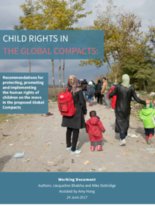INTRODUCTION
The New York Declaration for Refugees and Migrants is an important reaffirmation by Heads of State and Government and High Representatives of their intention “to fully protect the human rights of all refugees and migrants, regardless of status”. A key outcome of the Declaration is the creation of two new Global Compacts, one on refugees and one on migrants. These Global Compacts, to be agreed by government representatives at the United Nations (UN) in 2018, will articulate common commitments in respect of the protection of refugees and migrants. Regarding children, the New York Declaration contains a number of explicit guarantees, including:
We will protect the human rights and fundamental freedoms of all refugee and migrant children, regardless of their status, and giving primary consideration at all times to the best interests of the child. This will apply particularly to unaccompanied children and those separated from their families; we will refer their care to the relevant national child protection authorities and other relevant authorities. We will comply with our obligations under the Convention on the Rights of the Child.
This working document by the Initiative for Child Rights in the Global Compacts, a multilateral initiative supported by 26 organizations, sets out what these protection and inclusion measures entail with respect to six priority issues involving refugee and migrant children (sometimes referred to collectively as “children on the move”) and what provisions it would consequently be appropriate to include in the two Global Compacts. The six issues are:
- Non-discrimination
- Best interests of the child
- Child protection
- Child immigration detention
- Access to services for refugee and migrant children
- Sustainable solutions in children’s best interests
The six issues were selected because of their importance for refugee and migrant children and the commitments affecting them made in the New York Declaration, as well as other binding and soft law obligations in international law, particularly the UN Convention on the Rights of the Child (CRC). Each of these issues is presented in a separate section, opening with a summary of relevant information and references to existing commitments by States, notably those set out in international law and soft law instruments, some of which are summarized in the Recommended Principles for Children on the Move and Other Children Affected by Migration that were developed in 2016 and endorsed by the UN Committee on the Rights of Migrant Workers and Members of their Families in September 2016. The six issues do not address all the obligations that States have under international law to guarantee the rights of refugee and migrant children. Respecting the rights of all children, whether nationals or non-nationals, should underpin the provisions in the Global Compacts that affect children. It follows that States should ensure children’s right to be heard and take into account gender-related issues, both in the context of actions and decisions affecting an individual refugee or migrant child, as well as in the broader context of adopting laws, policies and practices affecting children.

